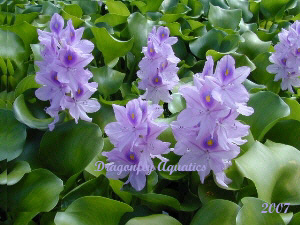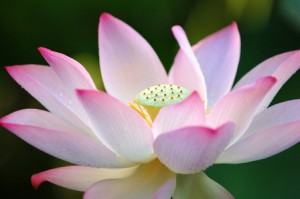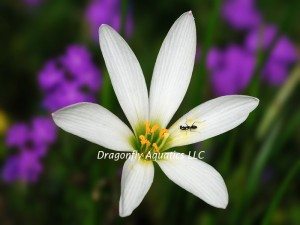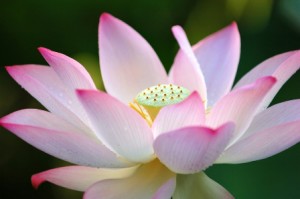Well mother nature looks like she's going to turn things around and start giving us in the north some warmer weather beginning next week. Usually May things start to warm up and it won't be long until we can begin putting out plants in the pond.
A good rule of thumb is always make sure your water temperatures are around 65 degrees before putting in new plants. Think of it like taking a bath in cold water. You'd shiver too and be a little shocked.
Lotus are a master piece in a water garden. Their outstanding flowers and large leaves whether in your pond or container are a beautiful addition to your water garden. Lotus are hardy perennials and will reward you with exotic flowers year after year.
There are small, medium and large lotus. Lotus won't start to appear in the spring until the water temperature warms in the pond which is about 65 degrees. In the colder areas where a lotus has been overwintered at the bottom of the pond, raise the pot so that it is just a few inches below the water surface and it will be warmed by the sun. If you overwintered the lotus in peat for the winter don't place it back in the pond until the water temperatures are 65 degrees. Once the water warms up in the 70s the lotus will start to grow more rapidly. They will begin to flower several weeks later than waterlilies, often not until late July and August in zones lower than 6 and zones earlier than 6 will begin earlier in July. They continue to bloom until late September and October depending on your climate.
So whether you have a large pond or just a small container on your patio a lotus will grow. I would suggest planting it in a large container and put in your pond, otherwise it could grow out of control. Keeping it confined in a container eliminates this. Planting it in a container it only requires a few inches of water over the tuber to grow. So whether you plant a lotus in your pond or simply plant it in a small container and set it on your patio, you will be glad you did.
There isn't much work to grow a lotus but the rewards are spectacular.
Signs of spring 2011. We're excited about the new lotus we have this year. We try to add one or two new a year. The new lotus for Dragonfly Aquatics are great lotus for those smaller ponds and containers. The Green Maiden and and Snow White. But sorry no Seven Dwarfs.
The flowers on the Green Maiden change from the first day from a soft pink to a pale yellow by the third day, similar to the Mrs. Perry D. Slocum only much smaller. The Green Maiden makes a perfect lotus for tub gardens and small ponds. It will grow 1' to 3' tall with flowers 2" - 3" across and its leaves will grow 18" to 20" across. Hardy zone 4 or higher, less than zone 4 with winter protection.
Snow White of China orgin is the perfect lotus for bowls and small containers with or without a pond. Double creamy white blooms of 3 - 5 inches with leaves of 6 - 12 inches and a height of 1 - 2 feet. It can be planted in a pond or just plant in a container at least 2 gallons or bigger with water 2 inches up to 10 inches deep. This lotus is considered a true bowl lotus. It is hardy zones 4 - 11.
In March we begin the task of harvesting the lotus tubers for the season. All lotus varieties are available for shipping. Lotus tubers are pulled while they are still dormant. The lotus tubers we sell at Dragonfly Aquatics have at least three or more growing tips, sometimes more depending on the variety. The tubers are kept in the dormant state in cold water until it is time to ship to your zone. Once the lotus tuber is placed in 65 - 70 degree water in the sun, it will begin to grow once again. Most varieties will bloom the first season.
You can read about planting lotus on our blog at https://www.dragonflyaquatics.com/blog/2009/03/pictures-of-planting-lotus/
Check out the lotus on our site.
HARDY LOTUS
As the lotus leaves begin to turn brown, the lotus is beginning to go dormant for the winter. Do not cut off the leaves; allow them to die back naturally. After they die back at this point, it is safe to cut them off above the water line. Its important to leave a portion of the stem above the water. You do not want water getting down the hollow green stem and having it get into the air channels of the tuber, if this happens you risk drowning the tuber and cause it to rot. Make sure the potted lotus is below the ice. Allowing the tuber to freeze will kill the plant.

Floating plants such as Water Hyacinth and Water Lettuce are considered tropical and will not survive temperatures below freezing. After the first hard frost, remove from the pond to prevent them from decaying and adding unwanted debris to the pond.
Three buds and anxiously awaiting the flowers....I keep thinking tomorrow the largest one will burst open only to find...
a larger bud. I'm not certain if this is the Perry Slocum or it could possibly be the Red Scarf. The Perry Slocum is one of my favorite lotus. I think its because of the changes it goes thru. It opens a pink and by the third day changes completely to a creamy yellow. I move things around in the ponds so often I sometimes forget where I put what. So a surprise is in store....maybe tomorrow.... meanwhile I'm back at canning those tomatoes. Tomato juice and salsa today. I also have a batch of green beans to can.
 We still have a nice supply of lotus tubers available. Many have multiple growing tips with leaves sprouting. There is still time yet this season to get a lotus started and growing in your pond. Lotus are magnificent additions to your water garden and at the current sale prices, now is the time to add one or several to your pond.
We still have a nice supply of lotus tubers available. Many have multiple growing tips with leaves sprouting. There is still time yet this season to get a lotus started and growing in your pond. Lotus are magnificent additions to your water garden and at the current sale prices, now is the time to add one or several to your pond.
Lotus are available here for a lowest price offered.
 As we get ready for another season, Dragonfly Aquatics is currently working on adding some new plants for the 2010 season. In the upcoming weeks we will be announcing our new plant varieties.
As we get ready for another season, Dragonfly Aquatics is currently working on adding some new plants for the 2010 season. In the upcoming weeks we will be announcing our new plant varieties.
The first we've added are our new Lotus for 2010. The Penelope and Double Rose. The Penelope is a pure white lotus and the Double Rose is a pink full lotus. Both are a great addition to our store. You can find more information on them on our site. https://www.dragonflyaquatics.com/lotus.html
The newest bog plant we've added this year is the Rain Lily or Zephyranthes candida. They have six-petaled flowers that are 1-3 inches across with grassy foliage and grow 3 - 10 inches tall. They grow in full sun to part shade in moist soil or water to 3 inches deep. They are a tender perennial bulbs and hardy in Zone 8 and up. They have however, survived in Zones 5 or 6. You can winter these over by taking them indoors. Just don't water them until you return them to the pond in the spring. They go dormant in the dry season and grow and flower in the wet season.
You can purchase Rain Lilies here on sale through end of March, 2010.
 In March we begin harvesting the lotus tubers for the 2010 season. In the next couple weeks most varieties will be available for shipping to planting zones 10, 9 and 8. Lotus tubers are pulled while they are still dormant. The lotus tubers we sell at Dragonfly Aquatics have at least three or more growing tips, sometimes more depending on the variety. The tubers are kept in the dormant state in cold water until it is time to ship to your zone. Once the lotus tuber is placed in 65 - 70 degree water in the sun, it will begin to grow once again. Most varieties will bloom the first season.
In March we begin harvesting the lotus tubers for the 2010 season. In the next couple weeks most varieties will be available for shipping to planting zones 10, 9 and 8. Lotus tubers are pulled while they are still dormant. The lotus tubers we sell at Dragonfly Aquatics have at least three or more growing tips, sometimes more depending on the variety. The tubers are kept in the dormant state in cold water until it is time to ship to your zone. Once the lotus tuber is placed in 65 - 70 degree water in the sun, it will begin to grow once again. Most varieties will bloom the first season.
You can read about planting lotus on our blog.
Check out the lotus on our site.
Use a container that is shallow and wide. Dwarf varieties, such as 'Chawan Basu' and 'Momo Botan' should be planted in containers at least 24 inches in diameter with a depth of 10-12 inches. Your regular size lotus do best in containers that are 3 feet in diameter. Planting lotus in smaller containers crowds them, resulting in fewer or no blooms.
Place clay soil into your pot. You want to put about 5 inches of dirt into your pot. Any more dirt in the container is unnecessary and may result in the container being too heavy to move. Then place the lotus tuber on top of the dirt with the cut edge of the rhizome against the edge of the pot.
Next take a flat rock and place it on top of the tuber. It isn't necessary to put dirt on top of the tuber. It will grow down into the dirt. The rock just keeps it positioned and keeps it from floating to the top of the container. You would next add about 2-3 inches of water to cover the tuber. Keep the container in a warm sunny location as the plant establishes itself. You will need to add water to compensate for evaporation as necessary. Once the lotus has produced several leaves, a shallow layer of soil may be added to cover the tuber, but isn't necessary. You want to be careful so you don't break the growing tip. At this point you can add a small gravel topping if desired.
Once the lotus has several leaves you can begin to lower it into your pond making sure you don't put the leaves under water. Eventually getting the container to the depth you want it. You can be quite successful growing a lotus in the container sitting on your porch or deck without putting it in a pond. Just make sure you keep adding water as it evaporates.
Now sit back and enjoy the fruits of your labor.
 Lotus are grown for their magnificent flowers, food and medicine. They are revered as a symbol of spiritual perfection. When grown in a pond, lotus are best contained in pots that prevent their tubers from running rampant throughout your water garden. They can overtake other plants if not contained in a pot.
Lotus are grown for their magnificent flowers, food and medicine. They are revered as a symbol of spiritual perfection. When grown in a pond, lotus are best contained in pots that prevent their tubers from running rampant throughout your water garden. They can overtake other plants if not contained in a pot.
Lotus cultivars are available in many sizes and colors. Some are considered miniature, while others can reach heights of over 6 feet tall with leaves reaching over 2 feet in diameter. Lotus begin to flower usually several weeks later than waterlilies, usually beginning in July and will continue to bloom until the first frost, into September and October depending on your climate.
Lotus are best grown in a rich, clay like soil and prefer an acid or neutral pH. They are susceptible to disease when they are grown in hard water that has a high pH. A good range would be 5.5 to 7.5 pH.
They prefer soil and water temperatures between 70 degrees and 86 degrees which kept at these temps will encourage rampant growth. In the early spring you may want to raise your lotus pot within a few inches below the water surface to be warmed by the spring sunlight. When first planting a lotus tuber you shouldn't put it in your pond until the water temps are about 65 degrees. Lotus should be fertilized regularly during the summer months. At least once a month is recommended. Take the fertilizer tablets and push them into the soil so the fertilizer reaches the tubers at the bottom of the pot. Make sure you push back the dirt over the fertilizer tablet so it doesn't dissolve back into the water, which can promote algae growth.
Planting a lotus is fairly easy and we found the best method to be successful is floating your lotus tuber. You would want to fill your pot roughly half full with soil and then add a few inches of water to the pot. Then float the tuber in the water and keep it in a sunny location keeping it warm , between 75 degrees and 86 degrees. Change the water every few days to prevent it from fouling and infecting the lotus tuber. Once the lotus plant has sprouted several leaves, gently place the tuber on the soil, holding it in place with a smooth, flat rock. As it begins to grow, it develops retractor roots that pull the tuber down into the soil. After your lotus has grown six or seven leaves you can place the plant in your pond increasing its depth gradually not covering the leaves.
Buy Lotus Here.